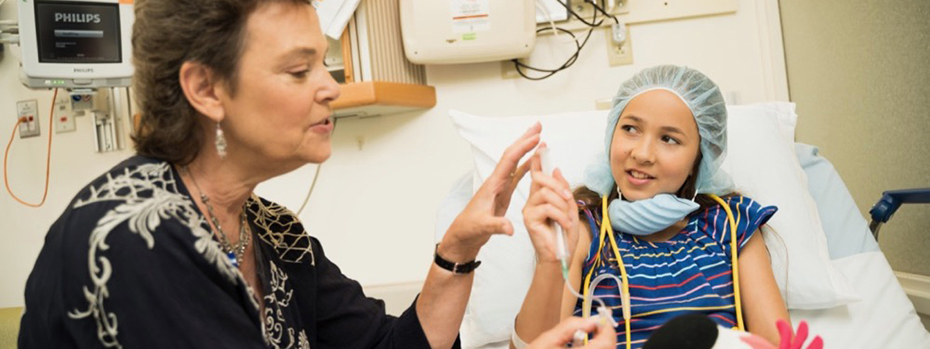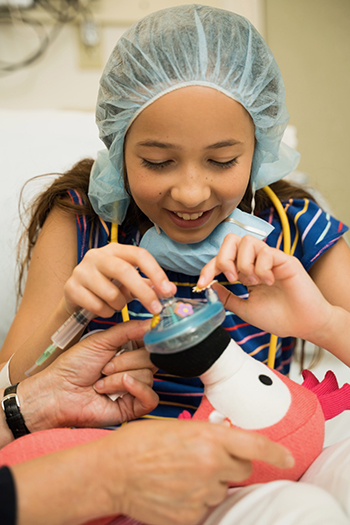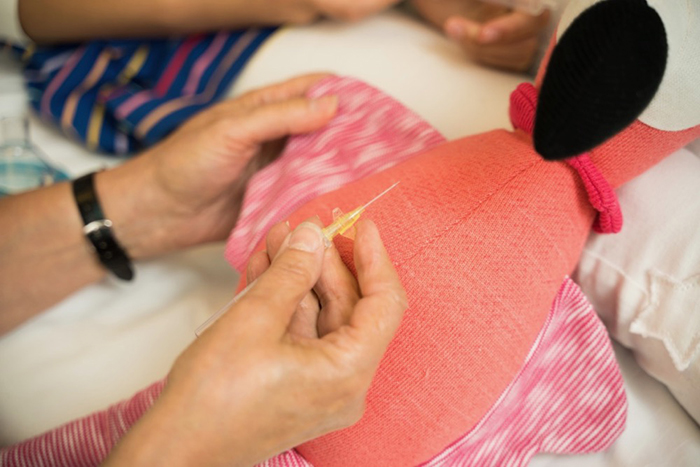Medical Play

Play is an important part of your child’s care plan at OHSU Doernbecher Children’s Hospital. Medical play can help you and your child reduce anxiety, know what to expect and feel more secure during your stay.
We offer you:
- An experienced team of specialists in child life and medical play.
- Strategies tailored to your child’s developmental and emotional needs.
- Medical play kits and art supplies to spark creativity and self-expression.
What is medical play?
You and your child are encouraged to play with real medical equipment and supplies such as stethoscopes, bandages, gauze, gloves, hats and masks. You can pretend to treat a doll or stuffed animal, do art projects, or role-play a medical experience. Our child life specialists can talk with you about the type of play that could help your child and show you how to do it.

and decorating the mask with stickers can help make medical
equipment seem less scary.
How does medical play help?
Medical play can:
- Help children express their feelings and understand what’s happening.
- Give their care team a chance to answer questions and address any misunderstandings.
- Reduce anxiety about medical tests and procedures.
- Help you and your child adjust to being in the hospital.
How you can help
- Let your child direct the play. Follow the child’s lead.
- Ask your child life specialist for ideas and materials.
- Supervise activities.
Therapy by age
Infant
Your baby’s separation anxiety and fear of strangers can increase in the hospital.
Suggestions:
- Play peek-a-boo with a doctor’s mask.
- Decorate a mask or hat.
- Explore a medical play kit with your child.
Toddlers
Toddlers are learning to talk and do more on their own. In the hospital, your child may be more afraid of strangers and separation than usual.
Suggestions:
- Play with and decorate a doctor’s mask.
- Pretend to treat dolls and stuffed animals with a medical play kit.
- Read books about going to the hospital.
Preschool
Preschoolers are learning language and self-help skills rapidly, and they often enjoy imaginary play. Your child may have trouble telling the difference between make-believe and reality.
Suggestions:
- Pretend to treat dolls and stuffed animals with a medical play kit.
- Do art projects with common medical materials, such as painting with swabs or making a collage with bandages, gauze and tape.
- Read books about medical experiences to your child.

School age
Your child can think in concrete terms and may take your words literally.
Suggestions:
- Use a medical play kit or real equipment to play out experiences on a doll.
- Make art such as collages, finger casts, syringe paintings or medical-supply sculptures.
- Read books about health care experiences.
Adolescence
Your child can think abstractly but may not connect actions to consequences.
Suggestions:
- Write a journal or blog.
- Make a scrapbook with writing, songs, poetry and photos.
- Create art out of medical materials.
For families
Call 503-418-5388 for more information.
Refer a patient
- Call 503-346-0644 to seek provider-to-provider advice.